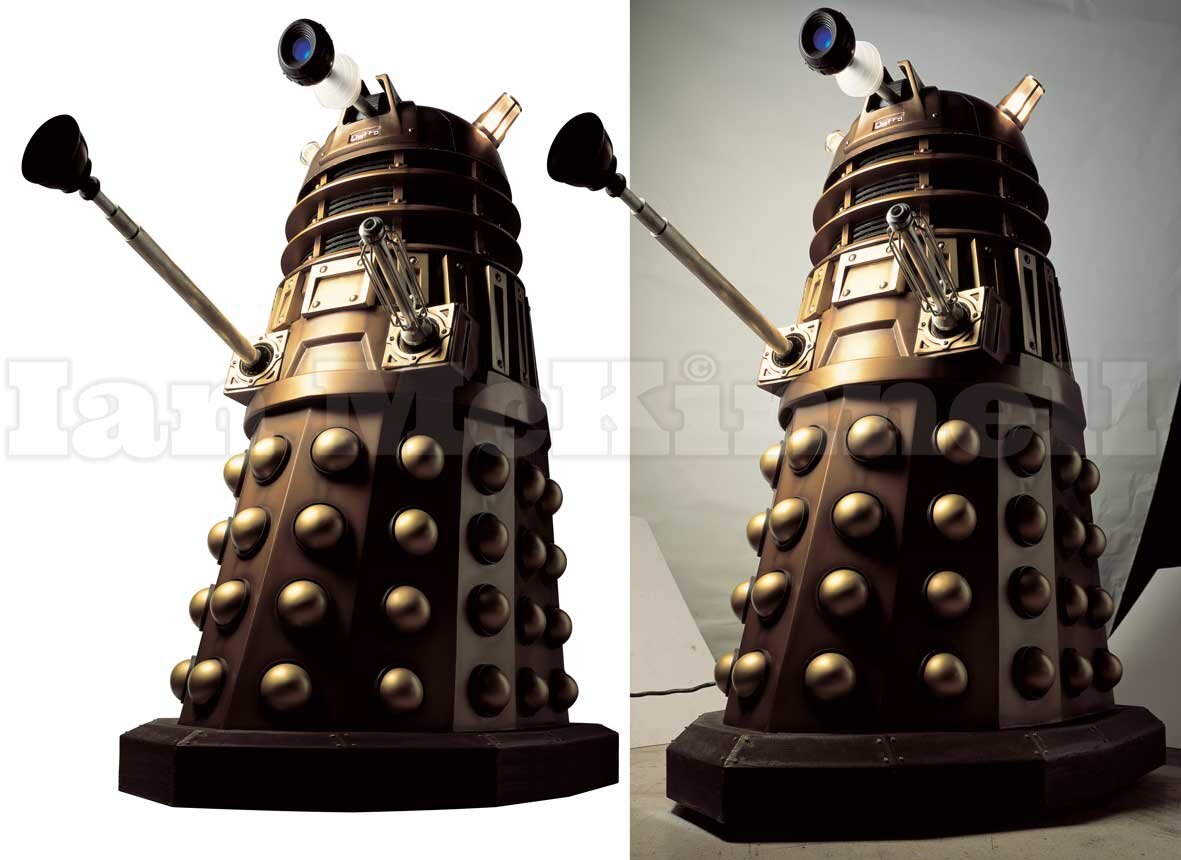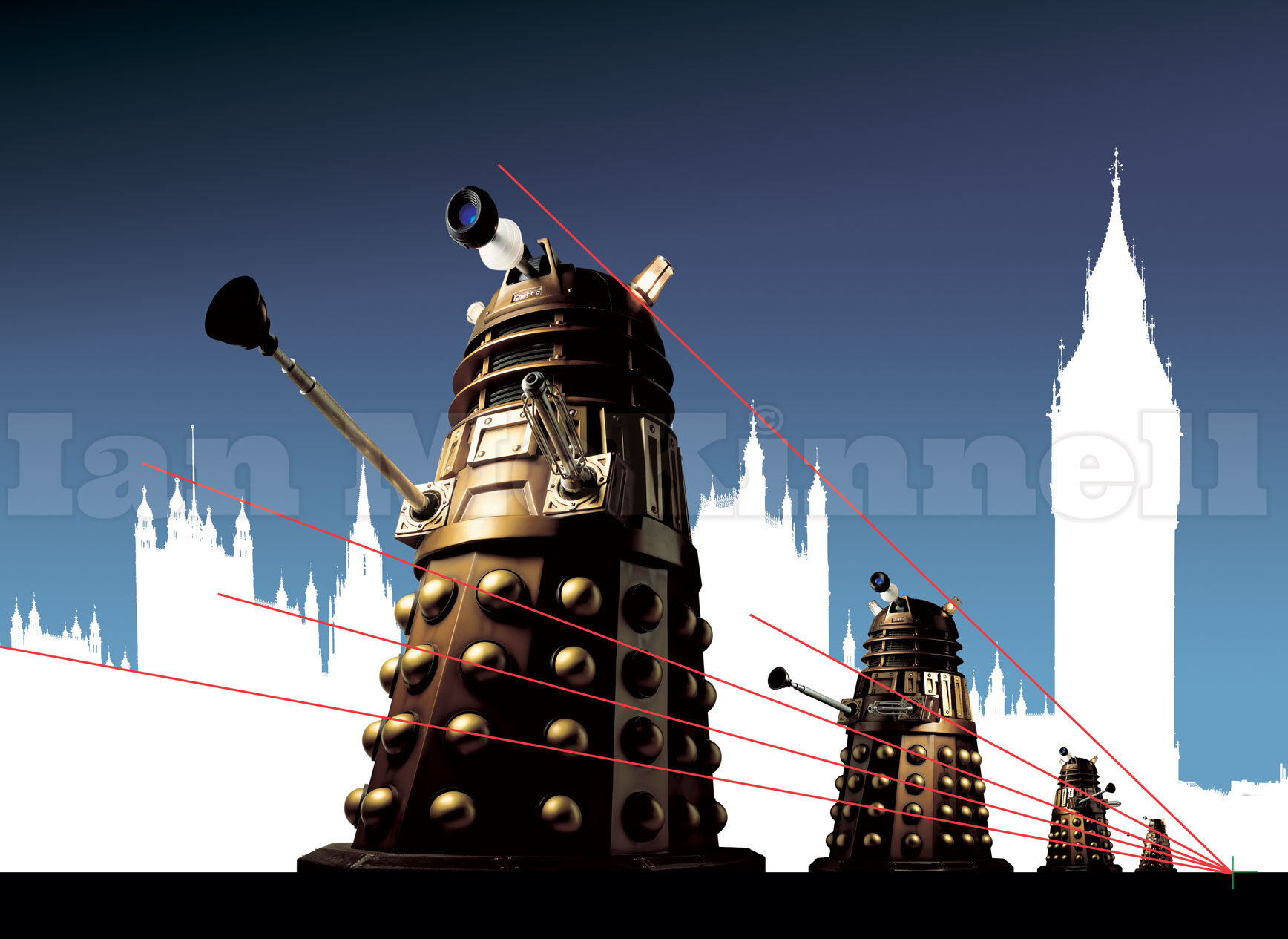The Radio Times magazine is a British institution, one of its oldest and best-selling publications. The Daleks were about to return to Doctor Who after an absence of 17 years and that same week there was to be a general election. Two big events in the same week deserved special treatment - a ‘gatefold’, folding out to double the size of the cover.
Planning the logistics of the Dr Who shoot on Westminster Bridge.
Radio Times Art Director Paul Smith’s inspiration came from a famous 1964 photograph of the Daleks crossing Westminster Bridge, striking terror into the hearts of children all over the land. Paul & I had worked on many Radio Times magazine covers together over the years & it’s always been a pleasure to work with him. He’s a big secret Doctor Who fan so this was very special for him too.
Preparation: At the time of the shoot Westminster Bridge was undergoing renovation work – the pavement was cordoned off with barriers and portable buildings. With Westminster Council's help, these were moved back and room cleared for the shoot. The barriers proved invaluable, helping to hide the shoot from pedestrians and passing traffic at a major tourist hot spot in the middle of the evening rush hour. The Daleks' new look – chunkier, armoured and metallic bronze – was a closely guarded secret, so there was no way they could be photographed on location in the centre of London. An old-style Dalek stood in to work out the composition, To prevent onlookers in double decker buses or on the nearby London Eye from seeing what was going on, the Dalek was hidden under a blanket except for a brief moment to shoot the Polaroid tests.
The Houses of Parliament at twilight. The building works on the bridge can be seen at the right hand side
The Shoot After setting up and waiting for hours for twilight it started to rain. I was worried that the lights I had set up would explode if wet, so I tried lighting the balustrade of the bridge with the headlights of my car, which worked better than the lighting I had planned! I saw a cormorant dive from the terrace outside the Houses of Parliament & emerge with a wriggling silver fish. I'd never seen that in central London before. These were the last photographs I took on film (the BBC requested it - I had been fully digital long before). It was the last time I used the Sinar P2 large format camera that I had worked with almost everyday for the previous 20 years. The final sheet of Polaroid. I think I may have something in my eye…
I normally used Fuji Velvia film for almost everything, but here I used Provia 100, which is softer in contrast and would keep some detail in the shadows of the two towers by the river which aren’t lit. I knew I could change the contrast during the retouching process later.
The set-up on the bridge was carefully sketched and the position of each element planned & measured using the old Dalek - especially the distance from the camera. A few days later in a film studio on an industrial estate on the outskirts Cardiff we met the stars. Security was very tight - we even had to leave our phones at reception before we could go in.
Perspective changes for the front Dalek as I couldn’t get the camera low enough in the studio.
There were 3 new Daleks, one was in bits with technical problems & another wasn’t working properly, so we had to photograph the one Dalek in lots of different angles as an operator brought it to life, carefully following the plan from the earlier shoot on the bridge. Perspective is not determined by the lens. It’s determined by the distance between the object and the camera. I couldn’t get the camera low enough in the studio for the leading Dalek - I had to change the perspective later in Photoshop when working on the photo-illustration.Years before we had an old Dalek in the studio for a few days & had great fun sitting inside & scaring visitors. So it was interesting to compare to this new more sophisticated version. But I’m not going to give away any secrets. Except…I’d been told that in the early series if a Dalek operator had to answer a call of nature they would normally trundle out to the car park, position the Dalek over a drain and er… well, it seems it’s true.
Making sure the perspective works
Not long after I had shot the Daleks word got out to the media (I don't know how, I suspect the film processors) & I was besieged by calls from Newspapers to get the photographs. One tabloid newspaper offered a lot of money to use them: far more than I was being paid by the Radio Times, but it wasn't a difficult decision. I had a lot of loyalty to Paul Smith & the Radio Times, and I held to my creative & strategic confidentiality as a matter of professional honour. So it was a firm no to all that cash on offer.
Starry sky with the Houses of Parliament masked
The starry sky was illustrated by hand in Photoshop. Each star was individual, as it can be very obvious when you copy & paste them. My son helped me with this, much to the awe of his school friends when they found out a couple of weeks later.
Initial Assembly before shadows and colour grading.
The magazine cover was a huge success. The Radio Times printed extra copies but they still completely sold out - a very rare occurrence. The art director & I could walk on water for a few weeks after that. The photo-illustration was produced as a poster which also sold out & was then reprinted in lenticular 3d.
Dalek exhibit at the Museum of London. Photo by Dun.can








